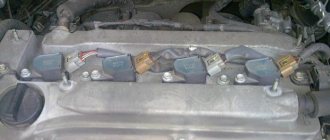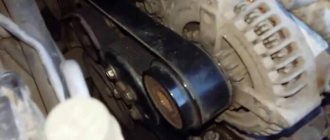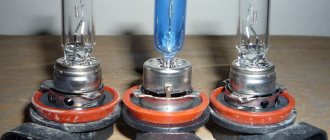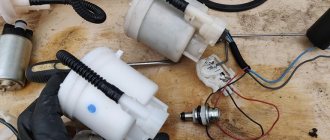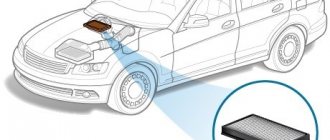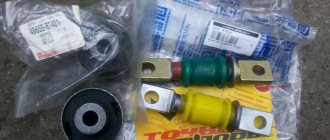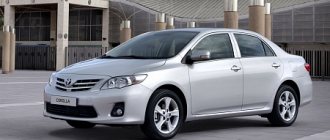When selecting a battery for a Toyota Camry, you must take into account the capacity and dimensions of the device. At the factory, cars are equipped with batteries from Japanese or European manufacturers (for example, Panasonic or Varta). The capacity of the DC source depends on the volume of the power unit, the list of additional equipment and the sales market.
Factory battery with characteristics
Toyota Camry cars use batteries with an Asian format housing. The direct current source is installed in the engine compartment on a special platform equipped with a tube for draining spilled electrolyte.
The product is reverse polarity (independent of generation) and is held in place by a transverse pressure plate with a nut. The negative pole of the power source is connected to the body; to restore capacity, a generator with forced drive from the engine crankshaft is used.
Main parameters:
- voltage - 12 V;
- capacity - from 60 to 80 Ah;
- starting current when the engine is cold cranked with a starter - from 580 to 700 A;
- case format - JIS;
- length - 261 mm;
- width - 175 mm;
- height - no more than 225 mm.
Table for different car generations
Depending on the generation, the Toyota Camry uses the following types of lead-acid DC sources.
| Generation | Capacity, Ah | Dimensions, mm |
| XV30 | 60-75 | no more than 260*175*225 |
| XV40 | 60-80 | no more than 260*175*225 |
| XV50 and XV55 | 68-80 | no more than 266*175*225 |
In the factory, machines are installed with products manufactured by Panasonic, Yuasa, FB or Rocket factories.
The parts on the assembly line have original markings; the Toyota concern supplies the parts to the spare parts market.
Factory power supplies are marked with 2 groups of symbols separated by a dash (for example, code 28800-0H160 corresponds to a factory battery of 65 Ah, with a starting current of 570 A).
Main reasons for lack of charge
The main reasons for the lack of charge on the Toyota Camry battery include:
- The most common reason may be that the battery has exhausted its potential resources. This happens after 4 or 5 years of use.
- Due to faulty wiring, the generator may not charge the battery during a trip, which will lead to the battery draining quickly.
- Perhaps due to problems there is a current leak in the on-board network. This can also be indicated by the charging light coming on.
- Rapid battery discharge is possible when you use the headlights or radio with the engine turned off, or forget to turn it off after a trip for a long time.
- If you do not prepare the battery for frost, when exposed to it (critically low temperatures), the battery may discharge.
Competent selection of analogues
A lead-acid battery suitable for installation in a Toyota Camry must have the following parameters:
- capacity of at least 65 Ah;
- cold cranking current - not lower than 570 A;
- housing and contact standard - Japanese JIS;
- reverse polarity (positive pole is located on the right);
- There is no need for a mounting bead along the bottom edge; the product is secured with a clamping strip.
When selecting an analogue, it is necessary to take into account that in machines of the XV40 generation and above, an increased amount of electronics with increased power is used. To ensure the operation of the devices, it is recommended to install a power source with a capacity of 75 A*h. In this case, the battery will be able to support the operation of the electronics when the car is moving at low speed (for example, in city traffic jams). It should be taken into account that at reduced crankshaft speeds, the generator does not charge the battery, which gradually loses capacity.
To maintain the charge level in electrical circuits, the Intelligent Battery Sensor charging control system is used. At the same time, the manufacturer uses starters with planetary gearboxes, which reduce the load on the power source when starting the motor. The injection system controller ensures the supply of gasoline at a crankshaft speed of 100-150 rpm.
At the same time, depending on the temperature, the composition of the fuel-air mixture is adjusted, which further reduces the load on the battery.
Top 5 batteries suitable for Toyota Camry:
- Panasonic 80D 26L MF, corresponding to the original product. It is distinguished by its increased cost and is supplied by official Toyota dealers. Capacity 65 A*h, starting current up to 600 A.
- Varta Blue Dinamic E23 with a capacity of 70 A*h, starting current 630 A. The DC source has increased starting power, original grids provide fast charging and are resistant to corrosion. It is recommended to use the device on cars with V-shaped 6-cylinder engines.
- Medalist 75D23L, providing starting current up to 580 A. The battery has a capacity of 65 Ah, recommended for cars with engines up to 2.5 liters. The design includes a peephole with a charge level indicator, which allows you to quickly determine the condition of the battery.
- Solite 95D26L with a starting current of up to 650 A. It features an increased capacity of up to 85 A*h, ensuring the maintenance of electrical systems on vehicles with additional consumers. There are no plugs in the housing design; there is a peephole with a float for determining the density of the electrolyte. The advantage of the products of the South Korean company Solite is the warranty period increased to 3 years.
- Exide Excell EB704 with a capacity of 70 A*h, the starting current is 540 A. It has increased starting power, there are plugs for checking the electrolyte level in the banks.
Factory
In the standard version, the battery of a Toyota Camry car is a battery from one of the Japanese manufacturers (and some foreign): Panasonic; Yuasa; Varta. The battery is Asian standard with right-hand positive, and this polarity must be taken into account when replacing.
In any generation, you can find only two sizes that are ideal for Toyota Camry, regardless of body modification (V10; V20; V30; V40; V50, etc.):
Find out the charging time of your battery
- 261*175*223 (70Ah).
- 230*175*223 (60Ah).
The battery is located near the left headlight, and the factory recommends installing batteries with dimensions identical to the standard ones, but installing batteries of a European standard is allowed.
The dimensions of such batteries should be:
- 243*175*190 (54-60Ah)
- 278*175*190 (70-77Ah) – not suitable for all bodies, and is selected individually.
Toyota Camry car
When choosing a battery for a Toyota Camry, you must remember that there are a huge number of consumers in the car, so batteries with increased capacity (75Ah) are a priority. This is due to the fact that the generator, with a large number of equipment turned on, may not be able to cope with the load, and additional devices may operate from the battery, discharging it. Batteries with a larger capacity, even in a discharged state, are able to start the engine and crank the starter, more reliably than a battery with a smaller capacity.
Signs of an unsuitable battery
If factory recommendations are violated, the battery case does not enter the installation site. The cable length is designed for a casing height of up to 225 mm; with an increased value, the terminals will not fit onto the contact pins. A product with straight polarity fits into its standard place, but it is impossible to connect the unit to the on-board network. When using equipment with reduced capacity or low current, the degradation of the electrolyte and active mass accelerates during cranking, and the battery fails after 1-2 years of operation.
Features of battery operation
A competent car enthusiast constantly monitors the condition of the battery, tops up distilled water once a week (you need to have at least a liter of distilled water in stock) to restore the volume and recharges the battery in a timely manner. When a battery is charged, it is necessary to periodically check the charge current so as not to exceed the specified value and not destroy the active mass of the plates.
Remember that before the winter period you need to charge the battery 12 hours a day and make sure that it remains on charge for the required period of time.
The best test for a battery is to start the engine at low outside temperatures. To make this process less painful for your battery and engine, follow these rules:
- change your summer oil to winter oil in time, no matter how much the toad presses you, buy good imported oil for the winter - ours has a habit of turning into jelly at low temperatures;
- before the cold weather arrives, replace the spark plugs in your Camry 40 with new ones, so that later on a frosty morning in a hurry you don’t have to stick your cold and shaking hands out and check the gaps in them, risking freezing your fingers;
- with the onset of frost, it is better to remove the battery from the car and place it at home in a cool place;
- In the fall, before the cold weather, charge your battery, setting aside at least 12 hours for this time;
- Before winter, check the wiring, fuses, condition of the generator and starter. If you can, replace the worn-out brushes and bearings of these units yourself;
- just before starting, turn on the high beams for a minute, this will help the active mass fill the battery plates;
- do not try to start the engine right away, first crank the engine by briefly turning on the starter to disperse the oil through the channels;
- We start by running the starter for 10-15 seconds and repeating the attempt 3-4 times.
Believe me, the engine will certainly start and proper operation of the battery will help you with this.
Briefly about battery operation
During operation, the battery capacity is maintained by a generator working in conjunction with an electronic relay controller. The active mass and electrolyte gradually degrade, which leads to a drop in capacity at low temperatures. The factory does not regulate the service life of the power supply; replacement is required after 3-5 years of vehicle operation. The battery life is affected by the driving mode (for example, during short trips in winter, the battery capacity is not restored, in this case it is necessary to periodically recharge it from an external unit).
At air temperatures below ... -20°C, the fluidity of motor oil decreases and a natural drop in the capacity of chemical batteries occurs. When you try to start the engine, accelerated degradation and chipping of the active mass begins. Impurities settle at the bottom of the case and create bridges between the negative and positive plates, accelerating the self-discharge of the battery.
Additional load is created by elements with damaged insulation (for example, alarm components installed by the owner).
Replacing the battery
When replacing the battery on a Camry, you must follow these steps:
- Stop the engine, set the parking brake and open the hood.
- Loosen the terminal on the negative pole (using a 10mm hex wrench) and remove the wire.
- Disable the plus; on later generation machines, the Intelligent Battery Sensor (IBS) charging control system unit is located at the terminal. The controller must be removed together with the terminal from the contact pin and moved to the side.
- Unscrew the pressure plate nut and remove the bracket.
- Remove the battery using the handle located on the case.
- Clean the cable clamps from dirt and traces of oxides.
- Wipe the area free of dirt, and if traces of electrolyte are found, deactivate the acid with a soda solution.
- Place the battery case on the standard platform and install the clamping bar. Do not over-tighten the nut as this may damage the plastic casing of the battery.
- Remove the shipping caps from the terminals.
- Install the positive cable of the on-board network, treat the terminal with a special lubricant that prevents the formation of oxides.
- Connect the negative cord and apply a layer of protective lubricant. If your car has an additional alarm system, open the driver's side door or put the keys with the remote control in your pocket before switching. When power is applied, the siren may be activated or the door locks may be locked.
- Carefully close the hood and test run the power unit.
Actions upon discharge
If the battery capacity drops, you must:
- Open the hood and disconnect the positive wire.
- Disconnect the negative cable and then remove the mounting plate.
- Bring the power source indoors and keep it for 4-6 hours at room temperature.
- Connect the charger with correct polarity. Turn on the unit in automatic mode; when using manual settings, set the current within 10% of the rated capacity. All manipulations are carried out in a ventilated room; if the jars have plugs, they should be unscrewed.
It is not recommended to restore the capacity of the car's power supply, since vapors or splashes of electrolyte fall on the metal elements of the car body. The average charging time for the product is 10-15 hours. If during maintenance there is an increase in the electrolyte temperature to +40°C or higher, then charging should be stopped.
How to choose the right battery
When a battery dies, it doesn't always mean it's time to change it. Often a battery can be revived with a simple charge. You also need to check for leaks in the wiring. Some appliances may draw current when the motor is turned off. In this case, even a new battery will deteriorate in a few days.
If there are no leaks, check the generator. Sometimes the battery does not charge due to a simple malfunction of the brushes. Too much or, conversely, insufficient charge harms the element. After making sure that there are no problems with charging, proceed to choosing a new battery. How to do it:
- Manufacturer. European, Japanese and Korean manufacturers are preferable to domestic ones. In Russia there are lower standards according to GOST. If in Europe a huge voltage is applied to the battery, which it must withstand for 30 seconds before losing charge, then in Russia it is only 10 seconds. Although, to be fair, it should be said that some domestic brands have learned to make a quality product. For example, Titan or Beast are almost as good as their foreign counterparts.
- Date of manufacture. Batteries do not last forever. The charge gradually weakens. And if storage conditions are not followed, the batteries deteriorate even faster. Therefore, it is advisable to buy batteries that were produced not very long ago.
- Capacity. The only rule is not to take an element with a lower capacity. More is possible, less is not. For example, a Camry 40 with an engine capacity of 2.4 liters has a 65Ah battery. That is, you can put 70Ah and even 75Ah, but not 60Ah or 55Ah.
- Starting current. The colder it is outside, the more difficult it is for the battery to turn the starter, since in cold weather the starting current decreases. There is even a concept - “cold start”. Therefore, the advice is the same as in the previous paragraph - either the same starting current as the original battery, or higher. For Camry 40 2.4 l is 630A.
- Guarantee. Giants such as Varta or Bosh provide a 4-5 year warranty, which speaks for itself. But their price is appropriate. Therefore, it is wiser to take a battery with a warranty period of 3 years. But if the manufacturer gives a guarantee for a year or two, you should think about the quality of its product.
Ideally, it would be good to check the battery with a so-called load fork, when current is applied for 10-20 seconds. In this case, the charge should not fall below 9V. If the charge drops to 8-7V, this means that the battery is very old or was not stored correctly.
Summing up
The selection of batteries for the Camry is carried out by the owner, taking into account the manufacturer’s requirements. If the product size is incorrectly selected, the terminals of the standard harnesses do not fit onto the contact pins. If you use a power source with an increased body height, the hood cover may be damaged. When the old battery is disconnected, the settings in the control units are reset, which adapt after 3-4 hours of vehicle operation. Until adaptation occurs, the engine may not operate correctly in idle mode and an error indication may appear on the instrument panel.
What to do if the battery is dead?
When the battery runs out of energy, it does not necessarily need to be replaced with a new one. Most often, it can be very easily charged from the mains by removing it from the car. It is also worth checking whether all devices are normal and working properly, and do not consume additional current.
If the problem is in the battery, then it needs to be replaced.
It is important to consider the polarity and size of the battery. Having selected and purchased a new battery, you should replace the old one.
The battery is replaced on a Camry as follows:
- First, loosen the terminals; to do this, use a 10mm wrench. Be sure to first remove the negative terminal, and only then the positive one.
- After this you need to remove the clamping bar.
- Then the old battery is removed and a new one is installed.
- After this, the bar is secured.
- When installing, first connect the positive terminal, then the negative one.
- Finally, you need to tighten the contacts.
Lead-acid battery design
When replacing the battery, the automatic control unit remains without power and the stored values and parameters are reset. Later, the new data will be stored in memory, and the car will operate as before. But before this, error signals may be issued. Sometimes the radio is blocked, in which case you will need to enter an activation key to resume its operation.
Which battery should I put in a Toyota Camry?
Toyota Camry is a very popular Japanese car, which was a huge success and is still produced by the largest auto giants in the world. They are collected in Japan, USA, Russia, China and Australia. The first model of a reliable Japanese car was presented to the public in 1982. In 2021, we see on the roads the 8th generation, which has been polished to perfection, but still the automaker never ceases to amaze us, offering even more advanced models with improved performance characteristics. You can order the battery using this link.

